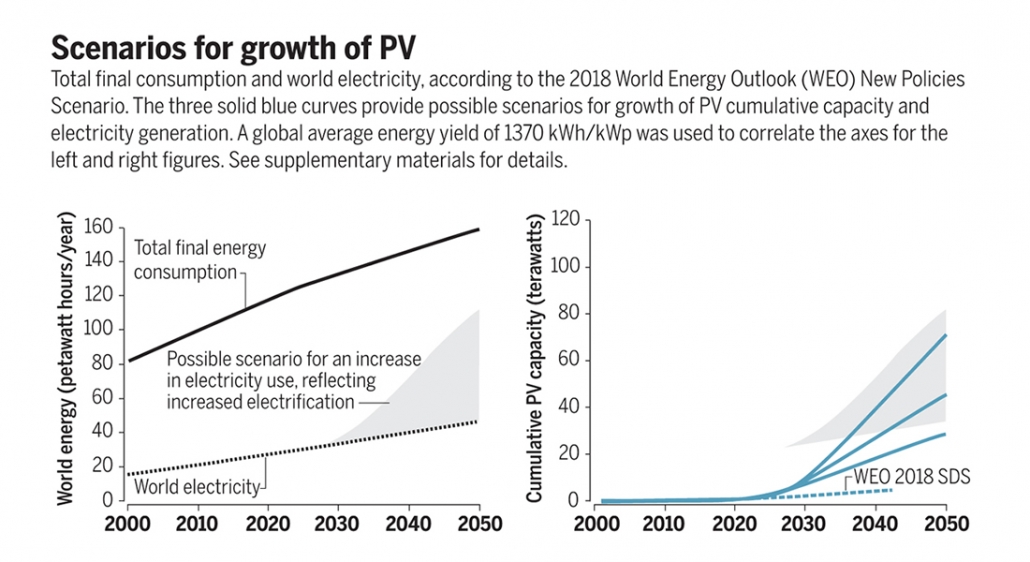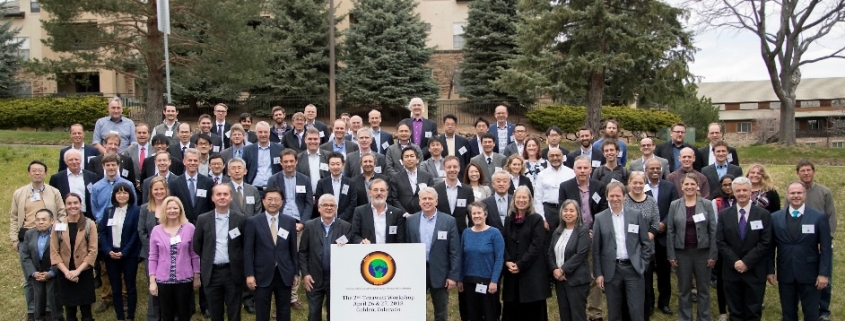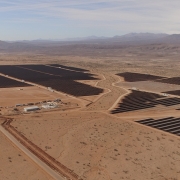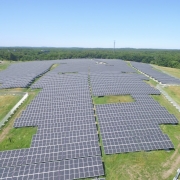PV researchers envision 10 TW by 2030 and up to 70 TW by 2050
Leading international PV researchers, gathered by the Global Alliance for Solar Energy Research Institutes (GA-SERI) to discuss the challenges for and arising from the deployment of PV and how to meet the global climate goals, have produced an article published on 31 May 2019 in Science entitled “Terawatt-scale photovoltaics: Transform global energy – Improving costs and scale reflect looming opportunities” describing the key points of the future developments.
The Global Alliance of Solar Energy Research Institutes (GA-SERI) is made up of the Fraunhofer Institute for Solar Energy Systems ISE, the National Institute of Advanced Industrial Science and Technology AIST (Japan) and the National Renewable Energy Laboratory NREL (USA). Since 2016, this group of international experts is joined by researchers from other groups and countries.
According to the article, the dramatic decline in the price of PV-generated electricity and the rapid expansion of production capacities make PV a game changer in the global energy system. In the future, solar power will not only be relevant for the electricity sector, but will also supply the transportation and heating sectors as well as industry and chemical processes. This presents both opportunities and challenges – on the energy system level as well as for R&D and industry.
Experts highlighted that the growth of the PV branch is faster than expected. While by the end of 2018, 500 gigawatts (GW) of PV capacity had been installed globally, they envision 10 terawatt (TW) by 2030 and 30 to 70 TW by 2050.
Dr. Andreas Bett, Director of the Fraunhofer Institute for Solar Energy Systems ISE said:
“PV module selling prices have decreased by more than two orders of magnitude in the last 40 years, by the end of 2018 they were below $0.25 per Watt. This led to a dramatic decline in the price of PV-generated electricity – relative to other forms of generation – and in many parts of the world, solar electricity is absolutely cost-competitive.”
The increasing share of PV in the total energy economy involves changes in the power generation and supply systems as well as in operation strategies and at the PV system level, the authors conclude.
Andreas Bett continues:
“The fundamental change in our energy system requires us to develop supplementary technologies like storage systems and also to drive forward sector coupling.”
Five areas of activity have been identified by the scientists:
Grid integration and power electronics
The supply-demand balance over larger geographic distances, storage capacities as well as improved solar forecasting help smooth some of the variability of solar resources. With increasing penetration of PV on the grid, PV systems increasingly provide grid reliability services such as voltage and frequency regulation. A new generation of PV inverters has been developed to this purpose. At a very high level of PV deployment, new techniques such as virtual oscillation controllers will be utilized, and the coupling with battery storage will create reliable and resilient systems.
Energy storage
The price of lithium-ion batteries has decreased by 80 percent in the past eight years, further improvements being expected due to increasing production capacities and technological advances. At the same time, R&D as well as industry are working on new cost-effective materials with higher energy density, as an alternative to lithium-ion batteries. A further option is pumped-storage hydropower for which there is a substantial technical potential worldwide.
Sector coupling
Electrifying the transport sector, which accounts for 39 percent of the total fossil energy consumption, and the heating sector (17 percent of the fossil fuel consumption) will dramatically increase the global share of renewables. Heat pumps as the future dominating technology for heating will significantly improve the energy efficiency of buildings. With cost-efficient solar produced hydrogen and ammonia, industries such as steel, iron and fertilizer production will be able to reduce their greenhouse gas emissions.
Power to X/Gas
Low-cost wind and PV electricity can be used to produce hydrogen, methane and other hydrocarbons. These can then be used as synthetic fuels and chemicals for industrial processes. By using power-to-gas or power-to-X technologies, many TWs of solar and wind capacities could be stored as chemical fuels over a longer period of time. The researchers see great potential for efficiency and cost-reduction.
R&D and production
According to the experts, the “learning curve” in PV – which in the past 40 years has shown a cost-reduction for modules of 23 percent per doubling of the installed capacity – will continue. Silicon PV, which accounts for 95 percent of the world market, shows a trend towards low-cost passivating contacts solar cells that allow higher efficiencies. Technological progress in the field of thin-film and emerging technologies has led to record efficiencies over 20 percent. Multi-junction solar cells based on silicon already have reached values above 35 percent.
Increased production volumes also require new R&D efforts: material supply (especially silver consumption), durability and recycling are coming into focus when we look at production on a terawatt scale.

Scenarios for growth of PV
Total final consumption and world electricity, according to the 2018 World Energy Outlook (WEO) New Policies Scenario. The three solid blue curves provide possible scenarios for growth of PV cumulative capacity and electricity generation. A global average energy yield of 1370 kWh/kWp was used to correlate the axes for the left and right figures. See supplementary materials for details.
GRAPHIC: N. CARY/SCIENCE
Source: Press Release by Fraunhofer ISE. Photo Credit: Fraunhofer ISE.









